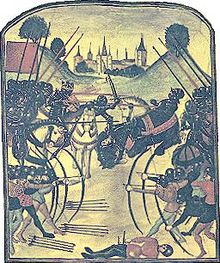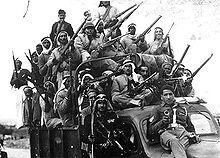A civil war is a war between organized groups within the same nation state or republic, or, less commonly, between two countries created from a formerly united nation state. The aim of one side may be to take control of the country or a region, to achieve independence for a region, or to change government policies. The term is a calque of the Latin bellum civile which was used to refer to the various civil wars of the Roman Republic in the 1st century BC.
A civil war is a high-intensity conflict, often involving regular armed forces, that is sustained, organized and large-scale. Civil wars may result in large numbers of casualties and the consumption of significant resources.
Civil wars since the end of World War II have lasted on average just over four years, a dramatic rise from the one-and-a-half year average of the 1900-1944 period. While the rate of emergence of new civil wars has been relatively steady since the mid-19th century, the increasing length of those wars resulted in increasing numbers of wars ongoing at any one time. For example, there were no more than five civil wars underway simultaneously in the first half of the 20th century, while over 20 concurrent civil wars were occurring at the end of the Cold War, before a significant decrease as conflicts strongly associated with the superpower rivalry came to an end. Since 1945, civil wars have resulted in the deaths of over 25 million people, as well as the forced displacement of millions more. Civil wars have further resulted in economic collapse; Burma (Myanmar), Uganda and Angola are examples of nations that were considered to have promising futures before being engulfed in civil wars.
Further definitions
Nevertheless the International Committee of the Red Cross has sought to provide some clarification through its commentaries on the Geneva Conventions, noting that the Conventions are "so general, so vague, that many of the delegations feared that it might be taken to cover any act committed by force of arms". Accordingly the commentaries provide for different 'conditions' on which the application of the Geneva Convention would depend, the commentary however points out that these should not be interpreted as rigid conditions. The conditions listed by the ICRC in its commentary are as follows:
Causes of civil war in the Collier-Hoeffler Model
Scholars investigating the cause of civil war are attracted by two opposing theories, greed versus grievance. Roughly stated: are conflicts caused by who people are, whether that be defined in terms of ethnicity, religion or other social affiliation, or do conflicts begin because it is in the economic best interests of individuals and groups to start them? Scholarly analysis supports the conclusion that economic and structural factors are more important than those of identity in predicting occurrences of civil war.A comprehensive studies of civil war was carried out by a team from the World Bank in the early 21st century. The study framework, which came to be called the Collier-Hoeffler Model, examined 78 five-year increments when civil war occurred from 1960 to 1999, as well as 1,167 five-year increments of "no civil war" for comparison, and subjected the data set to regression analysis to see the effect of various factors. The factors that were shown to have a statistically significant effect on the chance that a civil war would occur in any given five-year period were:
A high proportion of primary commodities in national exports significantly increases the risk of a conflict. A country at "peak danger", with commodities comprising 32% of gross domestic product, has a 22% risk of falling into civil war in a given five-year period, while a country with no primary commodity exports has a 1% risk. When disaggregated, only petroleum and non-petroleum groupings showed different results: a country with relatively low levels of dependence on petroleum exports is at slightly less risk, while a high-level of dependence on oil as an export results in slightly more risk of a civil war than national dependence on another primary commodity. The authors of the study interpreted this as being the result of the ease by which primary commodities may be extorted or captured compared to other forms of wealth, for example, it is easy to capture and control the output of a gold mine or oil field compared to a sector of garment manufacturing or hospitality services.
A second source of finance is national diasporas, which can fund rebellions and insurgencies from abroad. The study found that statistically switching the size of a country's diaspora from the smallest found in the study to the largest resulted in a sixfold increase in the chance of a civil war.
- Opportunity cost of rebellion
Low per capita income has been proposed as a cause for grievance, prompting armed rebellion. However, for this to be true, one would expect economic inequality to also be a significant factor in rebellions, which it is not. The study therefore concluded that the economic model of opportunity cost better explained the findings.
High levels of population dispersion and, to a lesser extent, the presence of mountainous terrain increased the chance of conflict. Both of these factors favor rebels, as a population dispersed outward toward the borders is harder to control than one concentrated in a central region, while mountains offer terrain where rebels can seek sanctuary.
- Grievance
- Population size
- Time

